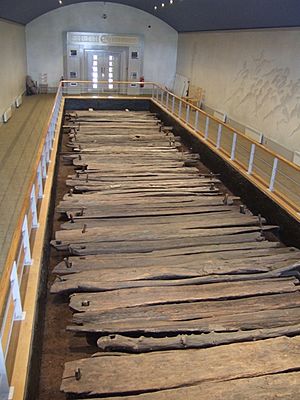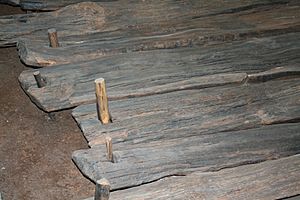Corlea Trackway facts for kids
The Corlea Trackway (Irish: Bóthar Chorr Liath) is an ancient wooden road, or togher, from the Iron Age. It is located near the village of Keenagh, in County Longford, Ireland. Local people used to call it the Danes' Road. This amazing trackway was built from strong oak planks around 148–147 BC.
Back in the Iron Age, the area around Corlea was very different from today. It was a dangerous landscape filled with bogs, quicksand, and ponds. Thick forests of birch, willow, hazel, and alder grew nearby. Higher ground had oak and ash trees. This wet and muddy land was very hard to cross for most of the year. Today, much of this land is used for digging up peat, which is a type of fuel.
In 1984, some wood found at Corlea was tested using a method called radiocarbon dating. This test helps scientists find out how old something is. They discovered the wood was from the Iron Age, not the Bronze Age as they first thought. Because of this important discovery, an archaeologist named Professor Barry Raftery started a big project. His team wanted to study the site before the peat digging destroyed it.
From 1984 to 1991, Professor Raftery's team found 59 ancient wooden trackways in the Corlea bog. Later, they found even more, bringing the total to 108 in Corlea and 76 in a nearby bog called Derryoghil.
Most of these ancient roads were made from woven hurdles (like fences) placed on top of piled-up branches. These were mostly for people walking. But four of them, including the main Corlea Trackway, were special. They were like "corduroy roads," made from split wooden planks laid on raised rails. These stronger roads could even be used by carts or wagons with wheels!
The Corlea Trackway itself was built using oak planks that were about 3 to 3.5 meters long and 15 centimeters thick. These planks were laid on rails about 1.2 meters apart. The road was at least 1 kilometer long. Scientists used dendrochronology, which studies tree rings, to figure out when the trees were cut. They found that the timber was cut in late 148 BC or early 147 BC, and the road was built right after.
Professor Raftery estimated that building the Corlea Trackway needed about 300 large oak trees just for the main planks. This would have been a huge amount of wood, needing thousands of wagon-loads. A similar amount of birch wood was used for the rails. The Corlea Trackway ended on a small island. From there, another trackway, also about 1 kilometer long, connected to dry land. Building these roads needed a lot of hard work, similar to building big ancient monuments.
We don't know for sure why the Corlea Trackway was built. Some experts think that smaller trackways might not have been for crossing the bog, but for getting into the bog. Perhaps people went into the bog for special ceremonies or rituals. The Corlea Trackway was a massive structure, so it might have also been used for important purposes within the bog, not just to cross it.
Whatever its reason, the road was only usable for a few years. The bog slowly grew and covered the trackway, and the wood also sank under its own weight. Within about ten years, or even less, the trackway was completely covered by the bog. This actually helped to preserve it for over two thousand years!
The fact that the Corlea Trackway was built so quickly, in just one year, reminds some people of an old Irish story. In the tale Tochmarc Étaíne (The Wooing of Étaín), a king named Eochu Airem asks a magical being named Midir to do impossible tasks. One of these tasks is to build a road across a bog where no road had ever been before.
See also
 In Spanish: Vía Corlea para niños
In Spanish: Vía Corlea para niños
Images for kids









